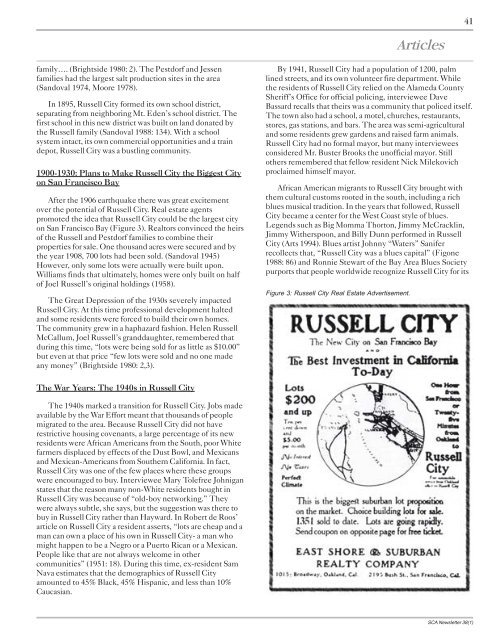March 2004 - Society for California Archaeology
March 2004 - Society for California Archaeology
March 2004 - Society for California Archaeology
Create successful ePaper yourself
Turn your PDF publications into a flip-book with our unique Google optimized e-Paper software.
41<br />
Articles<br />
family…. (Brightside 1980: 2). The Pestdorf and Jessen<br />
families had the largest salt production sites in the area<br />
(Sandoval 1974, Moore 1978).<br />
In 1895, Russell City <strong>for</strong>med its own school district,<br />
separating from neighboring Mt. Eden’s school district. The<br />
first school in this new district was built on land donated by<br />
the Russell family (Sandoval 1988: 134). With a school<br />
system intact, its own commercial opportunities and a train<br />
depot, Russell City was a bustling community.<br />
1900-1930: Plans to Make Russell City the Biggest City<br />
on San Francisco Bay<br />
After the 1906 earthquake there was great excitement<br />
over the potential of Russell City. Real estate agents<br />
promoted the idea that Russell City could be the largest city<br />
on San Francisco Bay (Figure 3). Realtors convinced the heirs<br />
of the Russell and Pestdorf families to combine their<br />
properties <strong>for</strong> sale. One thousand acres were secured and by<br />
the year 1908, 700 lots had been sold. (Sandoval 1945)<br />
However, only some lots were actually were built upon.<br />
Williams finds that ultimately, homes were only built on half<br />
of Joel Russell’s original holdings (1958).<br />
The Great Depression of the 1930s severely impacted<br />
Russell City. At this time professional development halted<br />
and some residents were <strong>for</strong>ced to build their own homes.<br />
The community grew in a haphazard fashion. Helen Russell<br />
McCallum, Joel Russell’s granddaughter, remembered that<br />
during this time, “lots were being sold <strong>for</strong> as little as $10.00”<br />
but even at that price “few lots were sold and no one made<br />
any money” (Brightside 1980: 2,3).<br />
By 1941, Russell City had a population of 1200, palm<br />
lined streets, and its own volunteer fire department. While<br />
the residents of Russell City relied on the Alameda County<br />
Sheriff’s Office <strong>for</strong> official policing, interviewee Dave<br />
Bassard recalls that theirs was a community that policed itself.<br />
The town also had a school, a motel, churches, restaurants,<br />
stores, gas stations, and bars. The area was semi-agricultural<br />
and some residents grew gardens and raised farm animals.<br />
Russell City had no <strong>for</strong>mal mayor, but many interviewees<br />
considered Mr. Buster Brooks the unofficial mayor. Still<br />
others remembered that fellow resident Nick Milekovich<br />
proclaimed himself mayor.<br />
African American migrants to Russell City brought with<br />
them cultural customs rooted in the south, including a rich<br />
blues musical tradition. In the years that followed, Russell<br />
City became a center <strong>for</strong> the West Coast style of blues.<br />
Legends such as Big Momma Thorton, Jimmy McCracklin,<br />
Jimmy Witherspoon, and Billy Dunn per<strong>for</strong>med in Russell<br />
City (Arts 1994). Blues artist Johnny “Waters” Sanifer<br />
recollects that, “Russell City was a blues capital” (Figone<br />
1988: 86) and Ronnie Stewart of the Bay Area Blues <strong>Society</strong><br />
purports that people worldwide recognize Russell City <strong>for</strong> its<br />
Figure 3: Russell City Real Estate Advertisement.<br />
The War Years: The 1940s in Russell City<br />
The 1940s marked a transition <strong>for</strong> Russell City. Jobs made<br />
available by the War Ef<strong>for</strong>t meant that thousands of people<br />
migrated to the area. Because Russell City did not have<br />
restrictive housing covenants, a large percentage of its new<br />
residents were African Americans from the South, poor White<br />
farmers displaced by effects of the Dust Bowl, and Mexicans<br />
and Mexican-Americans from Southern Cali<strong>for</strong>nia. In fact,<br />
Russell City was one of the few places where these groups<br />
were encouraged to buy. Interviewee Mary Tolefree Johnigan<br />
states that the reason many non-White residents bought in<br />
Russell City was because of “old-boy networking.” They<br />
were always subtle, she says, but the suggestion was there to<br />
buy in Russell City rather than Hayward. In Robert de Roos’<br />
article on Russell City a resident asserts, “lots are cheap and a<br />
man can own a place of his own in Russell City- a man who<br />
might happen to be a Negro or a Puerto Rican or a Mexican.<br />
People like that are not always welcome in other<br />
communities” (1951: 18). During this time, ex-resident Sam<br />
Nava estimates that the demographics of Russell City<br />
amounted to 45% Black, 45% Hispanic, and less than 10%<br />
Caucasian.<br />
SCA Newsletter 38(1)

















